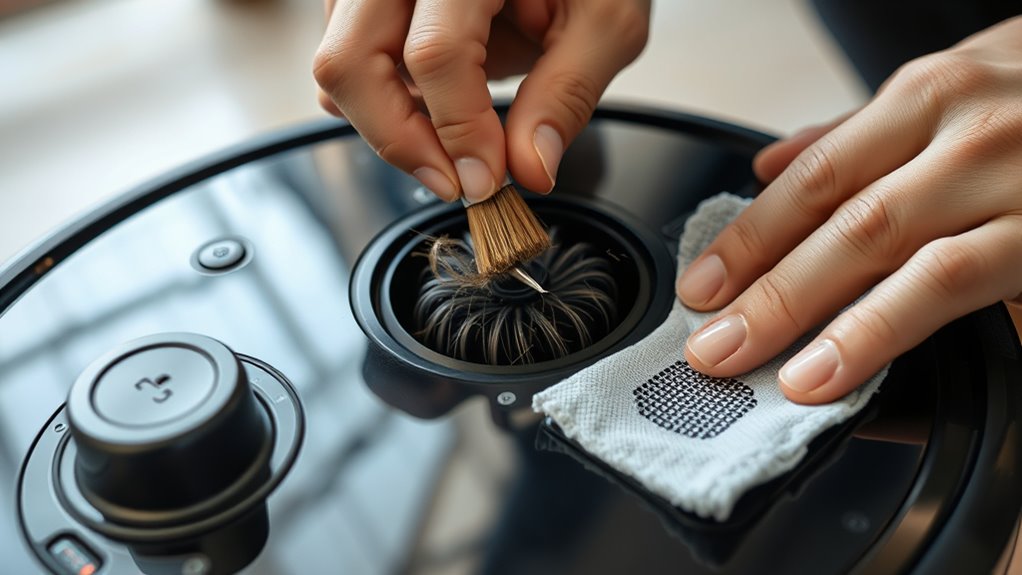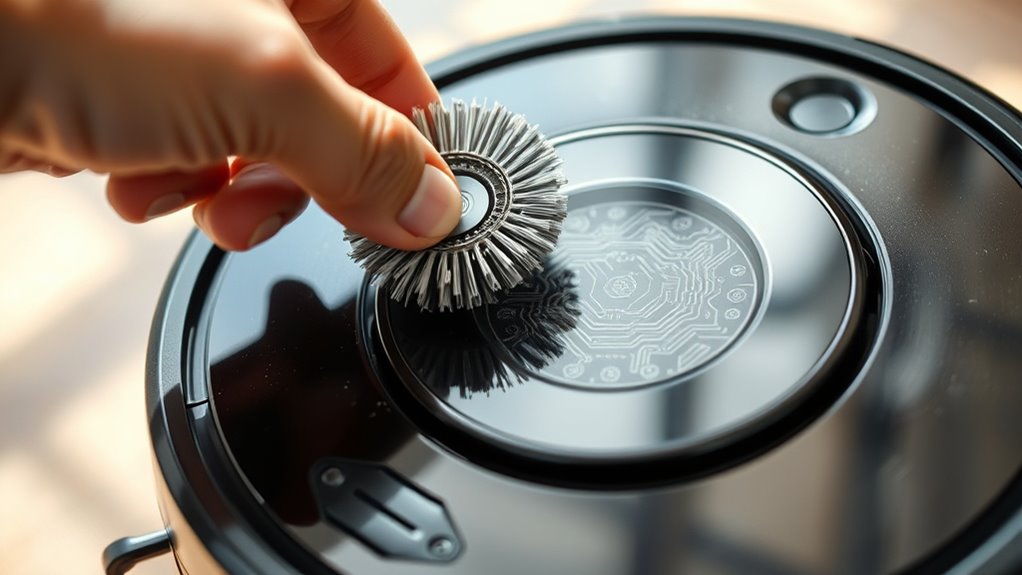To keep your robotic vacuum working efficiently, regularly clean the brushes by removing hair and debris with small tools or your fingers. Check for wear and replace them if needed. Gently wipe the sensors with a soft, lint-free cloth to prevent navigation issues. Keeping both brushes and sensors clean helps your device perform better and last longer. Continuing with these simple steps can lead to even better results and a smoother cleaning experience.
Key Takeaways
- Regularly remove tangled hair and debris from brushes using fingers or small tools to maintain suction power.
- Check brushes for signs of wear and replace them when worn out to ensure effective cleaning.
- Gently wipe sensors with a soft, lint-free cloth to prevent dust buildup and maintain accurate navigation.
- Keep sensors free of dirt to reduce collisions and prevent unnecessary battery drain.
- Perform software updates via Wi-Fi to improve device performance, navigation, and battery efficiency.

Have you ever wondered why your robotic vacuum isn’t performing as well as when you first bought it? One common reason is that its components, like the brushes and sensors, get cluttered with dust, hair, and debris over time. This buildup hampers its ability to clean effectively and can even strain the motor, ultimately impacting battery longevity. Regularly cleaning these parts keeps your device running smoothly and helps maintain ideal battery life. Additionally, staying on top of software updates is essential. Manufacturers often release updates that improve navigation algorithms, fix bugs, and enhance overall performance. Without these updates, your vacuum might struggle with navigation, causing missed spots or repeated passes, which can drain the battery faster and reduce its lifespan. Proper calibration and maintenance of the projector components can also significantly improve its overall functionality and image quality.
When it comes to brush cleaning, you should regularly remove hair, string, and debris tangled around the brushes. These obstructions can prevent the brushes from spinning freely, reducing their efficiency and increasing motor load. Use a small tool or your fingers to carefully detach any tangled material, and check for wear and tear. Replacing worn brushes ensures your vacuum maintains strong suction and effective cleaning power. Sensors, on the other hand, are indispensable for navigation and obstacle detection. Dust and dirt can obscure these sensors, causing your vacuum to misjudge distances or bump into furniture. Wipe the sensors gently with a soft, lint-free cloth to keep them clean and functioning properly. This simple step prevents unnecessary collisions, which can prematurely wear out parts and lead to more frequent battery drain due to inefficient navigation.
Keeping your vacuum’s software up to date is just as important. Manufacturers often release updates that improve sensor calibration, cleaning routes, and battery management. Most models connect automatically to Wi-Fi, allowing you to download updates seamlessly. If your device doesn’t update automatically, check the app or the manufacturer’s website for instructions. Regularly updating the software ensures your vacuum benefits from the latest performance enhancements, which can help conserve battery life. When combined with routine maintenance—like cleaning brushes and sensors—you’re setting your device up for longer-lasting performance. This proactive approach minimizes the chances of unexpected breakdowns and extends the overall lifespan of your robotic vacuum, making it a more dependable and efficient cleaning companion in your home.
Frequently Asked Questions
How Often Should I Replace the Sensors in My Robotic Vacuum?
You should replace your robotic vacuum’s sensors every 1 to 2 years, depending on their sensor lifespan and usage. Regular cleaning helps extend their lifespan, but if you notice consistent navigation issues or the vacuum isn’t responding properly, it’s time for replacement. Check your manufacturer’s recommended replacement intervals and consider upgrading sensors if they become damaged or lose accuracy, ensuring your vacuum maintains peak performance.
Can I Use Water to Clean the Brushes and Sensors?
Think of your vacuum’s brushes and sensors as delicate instruments that need gentle handling. Water cleaning may seem tempting, but it risks sensor damage and damaging the brushes. Instead, use a dry cloth or a brush to clean dirt and dust. Water can cause moisture to seep in, leading to malfunction. Keep your vacuum in top shape by avoiding water and opting for safe, dry cleaning methods.
What Are the Signs That Sensors Need Recalibration?
You’ll notice sensor accuracy issues when your robotic vacuum struggles with navigation, misses spots, or repeatedly bumps into obstacles. Calibration indicators may include inconsistent or erratic movement patterns. If these signs appear, it’s time to recalibrate the sensors. Recalibration restores proper function, ensuring your vacuum navigates efficiently. Keep an eye out for these cues, and don’t hesitate to recalibrate to maintain peak cleaning performance.
Are There Specific Cleaning Tools Recommended for Sensor Maintenance?
Think of your sensors as the eyes of your robotic vacuum—keeping them clear lets it see the world clearly. For sensor cleaning, you should use soft, lint-free cloths or microfiber cloths to gently wipe away dust and smudges. Small, soft brushes or compressed air cans also work well for removing debris from sensor crevices. These tools help guarantee your vacuum’s sensors stay precise and responsive, maintaining ideal cleaning performance.
How Do I Prevent Hair Tangles in the Brushes?
To prevent hair wrap and maintain your brushes, regularly check for tangles and remove hair promptly. Use scissors or a cleaning tool designed for brush maintenance to cut through stubborn hair. Avoid letting hair accumulate, which can cause tangles and reduce cleaning efficiency. Consistent brush maintenance, including cleaning off hair wrap, helps keep your vacuum working smoothly and prolongs its lifespan.
Conclusion
Think of your robotic vacuum as a trusty steed; regular cleaning of its brushes and sensors keeps it galloping smoothly. By giving it a quick brush-off and wiping down sensors, you guarantee it’s always ready for the next adventure across your floors. Neglecting maintenance is like ignoring a knight’s armor—vulnerable to dirt and breakdowns. Keep your robot in top shape, and it’ll keep your home spotless, riding on efficiency and reliability every time.









